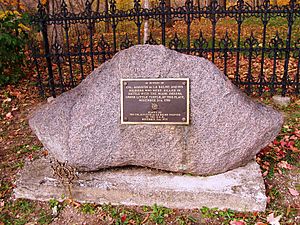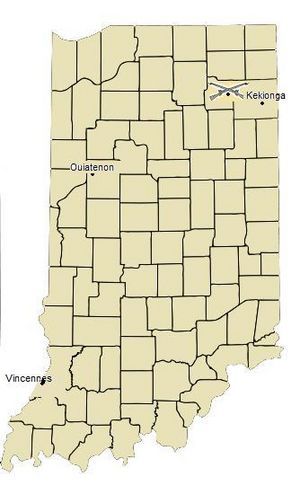Augustin de La Balme facts for kids
Quick facts for kids
Augustin de La Balme
|
|
|---|---|

DAR LaBalme Defeat Historical Marker on Dela Balme Road in Whitley County, Indiana
|
|
| Born | August 28, 1733 near Saint-Antoine, France |
| Died | November 5, 1780 (aged 47) Near present-day Columbia City, Indiana |
| Allegiance | France |
| Cavalry | |
| Rank | Colonel (United States) |
| Battles/wars | La Balme's Defeat |
Augustin Mottin de la Balme (born August 28, 1733 – died November 5, 1780) was a French cavalry officer. He fought in Europe during the Seven Years' War. Later, he came to the United States to help in the American Revolution. His plan to capture Fort Detroit in 1780 failed. He was surprised and defeated by Native American forces led by Chief Little Turtle.
Contents
Early Life and Military Service
Augustin Mottin was born on August 29, 1733, in the French Alps. He was one of 13 children. His father, Antoine Mottin, worked as a tanner.
Fighting in the Seven Years' War
Augustin joined the "Scottish" company of the Gendarmerie de France. This was a famous cavalry unit. He fought in the Seven Years' War, a big conflict in Europe. He was one of the French cavalry officers who survived the tough Battle of Minden.
After the war, Augustin studied how to ride and train horses. He became a master at the Gendarmerie's Riding School. In 1773, he retired with a pension. He then wrote two books, one about horsemanship and another about cavalry tactics. He used the name "Mottin de La Balme" for his books.
Helping in the American Revolution
Augustin de La Balme received a letter from Benjamin Franklin. He then traveled to the United States to help the Americans fight for their freedom. He arrived with other French volunteers, including the Marquis de Lafayette. La Balme said he was motivated by a "love of liberty."
In 1777, he was made the Inspector General of Cavalry for the Colonial Army. However, after the 1777 Battle of Brandywine, Casimir Pulaski was put in charge of all cavalry. La Balme was not at that battle. He resigned in October 1777 because he was no longer in command.
The Western Campaign and Detroit Plan
In 1780, La Balme traveled down the Ohio River to Kaskaskia. He was inspired by George Rogers Clark's success at Fort Sackville. La Balme wanted to try a similar attack on the British at Fort Detroit.
When La Balme arrived in Kaskaskia, local Canadien residents welcomed him. They had been living under British rule for over ten years. He presented himself as a representative of King Louis XVI of France. He collected complaints from residents about the Virginians.
La Balme did not think highly of General Clark. He saw Clark as an uneducated frontiersman. La Balme planned a distraction attack on Fort St. Joseph. Then, he started his journey to Detroit. He recruited local Canadian citizens from Kaskaskia, Cahokia, and Vincennes to join his militia.
At Vincennes, La Balme moved up the Wabash River. He hoped to get more soldiers from Canadian villages like Ouiatenon (today's West Lafayette, Indiana) and Kekionga (today's Fort Wayne). La Balme expected Canadian residents at Fort Detroit to join him when he arrived. His expedition marched under a French flag.
The Attack on Kekionga
La Balme's mounted force moved very quickly. They faced little resistance until they reached Kekionga. La Balme had planned to arrest Charles Beaubien, a British agent there. But Beaubien and many of the Miami people were not there.
La Balme's force raised the French flag. They raided British supplies for two weeks. They waited for more soldiers, but none came. When La Balme heard that a Miami hunting party was returning to Kekionga, he left. He planned to raid another trading post on the Eel River. La Balme left twenty French soldiers to guard the captured supplies at Kekionga. Then, he marched his main force towards the Eel River.
The Miami Indians learned about the intrusion. They attacked and destroyed the small group of men left at Kekionga. All twenty French soldiers were killed.
La Balme's Defeat
Chief Little Turtle lived in a village along the Eel River. He got permission from the Kekionga Miami to lead an attack. He gathered his warriors. On November 5, they attacked La Balme's camp at dawn. This was before La Balme reached the Eel River trading post. It was only 3 miles from Little Turtle's village.
La Balme and his men tried to defend themselves on the river banks. But they could only fire one volley before being overwhelmed. The battle was very one-sided. Only a few of La Balme's men managed to escape. Augustin de la Balme died in this battle. It became known as La Balme's Defeat.
What Happened Next
Even though La Balme's expedition failed, it worried the British quite a bit. Major de Peyster sent British Rangers to protect Kekionga. Fort Detroit stayed under British control until 1796, when the Jay Treaty was approved. (Detroit was later given back to the British in the War of 1812, but returned to the U.S. after that war ended.)
The British commander at Detroit, Major Arent DePeyster, thought La Balme had survived. He wrote in his log on November 13:
- "A group of Canadians from the Illinois and Post Vincennes arrived at Kekionga about 10 days ago. They entered the village, took horses, destroyed cattle, and stole from a store. The Indians soon gathered and attacked the Canadians, who were led by a French colonel. The Miami fought back against the enemy's fire. They had five of their group killed. But they were braver than savages usually are. They drove off the enemy, killed 30, and captured La Balme with his papers... I expect the Colonel any hour..."
The Spanish Governor at St. Louis, Francisco Cruzat, also wrote about it:
- "...I am very sorry for what has happened to Monsieur La Balme... he perhaps tried something too quickly. This undertaking needed more time, more strength, and better conditions..."
See Also



